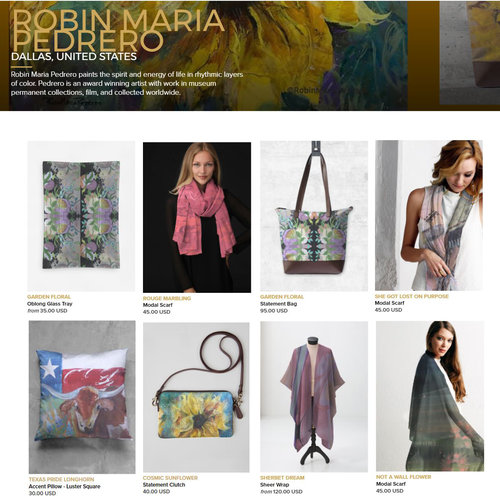by Carolyn Edlund
Many artists use print-on-demand services to sell products featuring their designs. This can be a revenue stream, but there are downsides, too.

Robin Maria Pedrero offers many different items in her shop on a print-on-demand site
What is print-on-demand (POD)? It is a way to leverage your art and create income, by working with third party providers. These providers, such as Café Press, RedBubble, Vida, Society6, Fine Art America others, manufacture products that bear your artwork or design. See our directory of 250+ Places Artists Can Sell Online to find many of them listed in the “Print on Demand” category.
In this business model, the artist acts as a licensor in a contract with the POD provider. The artist agrees that artwork of their choice may be used by the provider for the purpose of creating specific products for sale. A portion of the sales price is paid to the artist. Artists upload images to be used per the instructions on the provider’s website.
When you visit a POD website, you’ll see that these providers offer a list of products that can be sold with the artist’s work on them. Those products range from clothing (such as t-shirts, scarves, leggings, dresses, etc.) to home products (like wall art, mugs, pillows, clocks and shower curtains) to personal items (examples are cell phone cases, purses, journals, etc.) and more.
How It Works
In this arrangement, the artist provides the images to be used on products. They have few other responsibilities than promoting, marketing and driving traffic to their page on the print-on-demand website. POD providers do the rest, including:
- Maintaining and marketing an e-commerce website for displaying and selling merchandise
- Providing merchant card services
- Manufacturing products ordered by customers (thus the name “print on demand” which reflects the “one off” nature of the process)
- Fulfillment of orders – packing and shipping to the customer
- Customer service
- Providing stats and information for artists who sell on the platform
- Making payments to artists for items that are sold
As you can see, POD providers do the lion’s share of the work in the sales and fulfillment process. That means that they keep the greater portion of the sale price, because they have earned it. Artists may be paid their share in a couple of different ways. They may earn royalties, which is a percentage of each sale, as specified by the provider in their terms. Or, they may earn the markup over the stated bottom line cost of the product.
Benefits of Print-on-Demand
Using print-on-demand increases the number of formats you can offer. It helps spread your collection to offer different products and a variety of price points. If you usually only sell original art, for example, reselling printed products obtained directly from these providers (at the artist discount) can give you the opportunity to resell them at retail fairs and festivals for additional income.
Artist Robin Maria Pedrero has used print-on-demand services for a number of years. She currently works with 5 or 6 providers to create products that she sells to her audience both on and offline. Robin indicates that this provides a small side stream of income for her that varies from month to month.
“Artists should be aware that quality control can be an issue,” she says. “Do your research so you know how the products will turn out. Buy from yourself, so you understand the product and the buying experience. Knowing not only the quality but the level of customer service is very important.”
Pedrero also explains that artists typically will not know who bought their products online. This information is often retained by the POD provider but not shared with the artist. Buyers may expect you to be grateful for their purchase and thank them personally, when in actuality, you don’t know that they purchased because you aren’t given customer details.
She also recommends that artists choose products carefully. Pedrero tends to design specifically for product. She knows that if she creates an image that would be perfect for a scarf, or a shower curtain for example, it will look great and sell more easily.
Drawbacks
POD providers and services differ. Finding sites that fit your needs will take some research. Some platforms may prove to be cumbersome or difficult to work with. In that case, move on and identify the right ones you want to work with for the long term.
Why might print-on-demand not be a good fit for your business? If your artwork doesn’t lend itself well to print on products, you might take a pass on this model. Do you feel your artwork would be devalued by using POD? Then stay away. If you work with galleries who frown on seeing your art on products, honor your agreements with them and don’t participate. Or, discuss the topic with them if you want clarity on the topic.
Some artists feel that their work belongs on a canvas and in original form, and don’t want reproductions of any kind made, including prints on canvas, aluminum or other substrates. If this describes you, it’s better to stay true to the vision you have for your business, your market, and your collectors and forego the print-on-demand world.
Artists have many opportunities to market and sell their work. Print-on-demand offers one option. If you think it may be a good way to drive extra income and believe the benefits would fit your business well, review our directory for a listing of providers.


[…] manuscripts, create a cover, and set up a distribution channel to sell their books.Another type of POD business is an artist-centric business. This is where artists can sell their prints, paintings, or sculptures […]